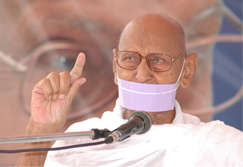
South Asia Mail

There is an instructive story in one of the Puranas. Once the god Indra and his spouse, Indrani, while wandering in the world came to a village. The people of this village lived a life of abject poverty. Indrani pitied these people and requested India to remove their poverty and make them prosperous. The life of the villagers will be a happy life, if there were plenty in the village. Indra, however, did not agree. He thought that it was not possible for man to be happy even if he possessed enough to eat and drink, and lead a life of prosperity. But he had to yield to the wish of his spouse when the latter persisted in her request. He produced a mine containing gold outside the village. When the villagers came to know of this mine they rushed to it in order to get gold. Every one took as much gold as he could.
Next day they began to talk about what had happened. They became jealous of each other. No body was prepared to accept another as equal to himself, Indra asked his spouse to note the consequences of what she had asked him to do. The moral of the story is that happiness and contentment are not based on our possessions but upon the kind of mentality we possess. Ambitions and jealousies are the products of passions, which force us to enter into unjust struggles and unfair competitions with our fellow beings. A life devoid of passions is a pure life and one who lives a pure life will never mind what others are and what they do to him.
Bhagawan Mahavira came across lots of people hostile and unkind to him in the course of his Sadhana. People called him names, jeered at him and even threw stones at him while he was engaged in his solitary meditations. But he remained unperturbed. He continued his meditation forgetful of what others did to him. It was because he had changed the direction of the flow of his consciousness and had attained complete mastery over his passions. He did not attach any value to the experiences in this world. He lived a life of his own. Scores of charming women tried to defile his mind during the course of his meditations and failed. He had renounced the life of great comforts and taken to the hazardous life of a wandering mendicant because he had brought about a reorientation in his attitude towards life itself. This reorientation is called Vrata, Pravrajya, or Sanyasa.
Ahimsa is a consciously adopted Vrata. It is deliberate action and not an instinctive reaction. Truth means action, Untruth means reaction. Prestige and possessiveness are not actions of the soul but only reactions born of passions. One who has given up passions and given a spiritual orientation to his consciousness remains unattached to the pleasures of the life of the senses and feelings. He becomes unfettered and free. Vrata or Samadhi is nothing else but this reorientation of our consciousness.
Gautama once asked Mahavira: "Sire, is it true that some people sleep, some keep waking and some sleep even while waking?" Mahavira replied, "Gautama, it is true. One whose consciousness is orientated towards the world outside his self sleeps. One whose consciousness is orientated towards the self is awakening. One whose consciousness is divided between the self and the world outside he sleeps even while he is waking." Vrata is a state of waking, of pure consciousness. It is a Samadhi. It is Samadhi, because he, who has attained this state, becomes free from all kinds of doubts and uncertainty.
The circle of Kasaya has four parts and each one of them has to be assaulted in order that the soul may become free. If the Anantanubandhi sector of this circle is breached, it results in Samyak Drsti or right perception. If the sector known as Apratyakhyani is breached, it results Vrata. If the sector known as Pratyakhyani Kasaya is breached, it results in Mahavrata. Mahavrata is also called Diksha (initiation) or Pravrajya (renunciation). If the fourth sector known as Smjvalna Kasaya is breached, it results in freedom from attachments and aversions, which is the state of a Vitaraga.
Vrata and Mahavrata are achieved only when consciousness has been freed from passions. Vrata is a great Samadhi of union. Once this state has been achieved, violence, anger, pride, deceit, and greed disappear once for all. There are then no attachments and aversions. So far as one remains encircled by passions, his mind wavers and courage fails due to a sense of uncertainty. Rati means attachment to the world of the senses. Virati means freedom from passions and the attachments born of them. Virati is the orientation of consciousness towards the self.
What is the cause of the reorientation of consciousness and a change of attitude? Why do we become self orientated? Reorientation of consciousness does not mean giving up life. It simply means a change in the direction of the current of consciousness. It means a change of values and interests. It means the elimination of the tastes created by passions and attachments and aversions. The example of the life of the emperor Asoka is a classical example of the change of consciousness. He was a very ambitious emperor and was bent on conquering the world. After the terrible experiences of the war of Kalinga there came a sudden change in his attitude. The direction of his consciousness suddenly changed. He became self minded.
The kingdom of the self proved to be more attractive than the sovereignty of the entire world. The values of life changed and the area of his interests became centred round his own self. This was a spiritual change in him. There is only one Vrata, but it may be classified into many according to convenience. In its essence it is a change of the direction of consciousness.
 Acharya Mahaprajna
Acharya Mahaprajna